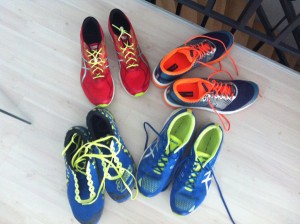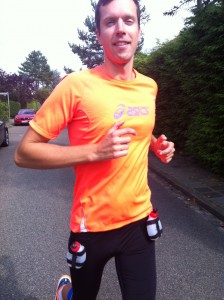 For over half a year I had the opportunity to extensively test some of the ASICS models, both in training and in competition. On the left you can see my current running shoe cabinet. I am 1.91 m tall, weigh 80-85kg (depending on the time of year) and am a neutral foot runner, at least I prefer no or only minimal pronation supports in the shoe.
For over half a year I had the opportunity to extensively test some of the ASICS models, both in training and in competition. On the left you can see my current running shoe cabinet. I am 1.91 m tall, weigh 80-85kg (depending on the time of year) and am a neutral foot runner, at least I prefer no or only minimal pronation supports in the shoe.
Let's start with the red Gel DS Racers at the top left. By far the lightest shoe I've run so far. approx. 213 grams in my size 47.5! You can also feel the weight advantage directly. If you imagine how often you lift your feet within 10km, a few grams add up to a noticeable difference. In principle, weight directly on the foot hinders moving forward more than if the weight swings around the waist, for example. Ie a full drinking belt, although much heavier, slows you down much less than a heavy shoe. So your shoe should first and foremost be as light as possible. However, there are limits to this, because it still has to cushion and support the foot enough. Otherwise everyone would run barefoot 😉 Which, by the way, I've already tried. However, within weeks you would get massive Achilles tendon problems due to the heavy muscular strain on the calves.
But I digress. For me, the Racer is a shoe that optimally fulfills these conditions. Extremely light, but still just bearable for the marathon. You can easily test it. If you can run a shoe on your long run without getting muscles made of stone afterwards, then you can also do it in the Wettka mpf run. The softer the ground during a competition, the flatter and lighter the shoe can be, because the ground is then softer than, for example, asphalt. Ie in Roth you can run more aggressive shoes on the gravel than in Hawaii.
mpf run. The softer the ground during a competition, the flatter and lighter the shoe can be, because the ground is then softer than, for example, asphalt. Ie in Roth you can run more aggressive shoes on the gravel than in Hawaii.
Let's go further down on the left to the Gel Noosa Fast in blue. I like to run this in short triathlons. On the one hand it is almost as light as the Racer and on the other hand it is very comfortable. So you can easily walk it barefoot with wet feet. Plus, he's getting dressed pretty quickly. I would run this up to the middle distance. Only the sole rubs off quickly. The shoe will probably not get too old compared to its other colleagues. But since it is purely a competition shoe, this is not particularly tragic.
At the bottom right you can find my daily companion, the Gel DS Trainer. For me, it has to be able to eat up kilometers. But it is still relatively light and very direct. I used to run the New Balance Trainer. This always felt like a sofa on the foot and was also a little heavier. With this one I can also incorporate a few speed things. So great shoes for everyday use.
The last one in the group, the Gel Lyte 33 is more of a shoe that you can use from time to time to expose the foot to other stimuli. It's relatively soft and, in my opinion, is well suited for forest stretches and cross-country trails. For me personally it is not stable enough. Here I have the feeling that with every step I feel a minimal loss of strength or cannot find a real impression.
A few more words about the running shoes. You should give each shoe an approx. 48 hour break and lay it on its side when storing it. Background: after training, the sole is crushed by the load. This expands again in the resting phase. Ie if you give the shoe the necessary break, then you will benefit much longer. Therefore, always run several shoes in parallel, which you then switch.
skin in!
krelli

